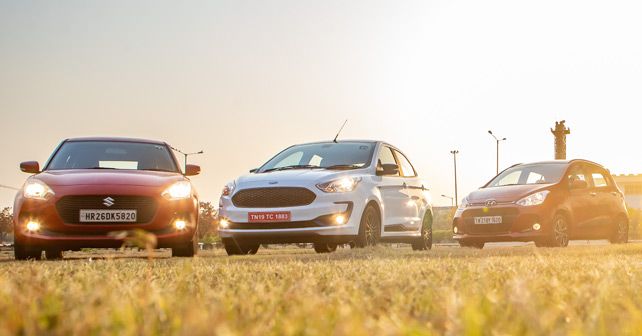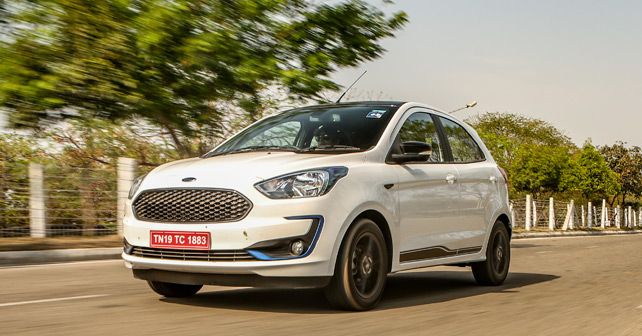In a market full of humdrum commuter cars, the likes of the Figo Blu and Swift form a silver lining for enthusiasts on a budget. But how do they fare alongside more mainstream machines like the Grand i10?
Good, bad, foolish – we’ve all tried to make every sort of excuse in our childhood to achieve our all-important objectives at the time, be it in negotiating for more playtime or coming up with the perfect reasons as to why we ought to beat up another kid. Growing up is an endearing time, but honestly quite the struggle too if you rank high on the mischief scale. There were times when I would often dream of just being handed all the legitimate excuses that would allow me to simply go out and do everything I wanted. In all honestly though, I wouldn’t have been able to handle it – just thinking about it used to make me feel like exploding with joy.
I felt something similar recently – an intense sense of excitement with a conspicuous hint of elation – when the guys at Ford rang me to hand me the keys to the Figo diesel, once again. I was looking forward to that exhilarating feeling of zipping past everything on the road – within legal limits of course – in an inspiring machine, a feeling that significantly adds to the pleasures of driving.
The reason that this opportunity landed on my lap is courtesy of the Figo’s mid-cycle update.
What’s new?
Ford has given the Figo a new touchscreen infotainment system, a new petrol engine, a new automatic gearbox for select petrol models and a new name for the top-end model, the Blu – which has blue plastic inserts on the bumpers and interior door pads, along with blue stitching on the seats.
The new top-end variant also gets larger 15-inch black alloy rims, black ORVM casings, an all-black front grille and a black roof that remind you of the erstwhile sporty Figo S. Oh, and there are also some weird black stickers on the doors and hatchback lid. These changes aside, the Figo remains the same as before. And that’s a good thing, for the earlier diesel model was quite good from behind the wheel.
Now, before you come at me with kitchen knives for not testing the new petrol model – well, Ford only had the diesel Blu test car available.
More than meets the eye
You see, while the Figo Blu seems to be the same car as before, at least on paper, from the driver’s seat, it feels markedly different – and a short stint behind the wheel was enough to reveal this fact. The new Blu model, in fact, feels like a reincarnation of the Figo S. So, it has a stiffer suspension setup and a more taught steering wheel, which make this car quite sporty. The car has indeed been significantly transformed and has left us enthusiasts amply excited, considering just how brilliant this car has become to drive.
The Figo diesel has always been the most powerful car in its class – its 99bhp engine is an absolute tower of power. Add to that the new sporty twist, and the car now seems to be in a league of its own.
Part of what makes this car great to drive is that the engine has a very wide power band – the throttle response post 1,000rpm is extremely good. Even though the turbocharger spools up around 1,800rpm, there’s no lag below it. It’s only when you mash the accelerator pedal that you feel some of the turbo lag that’s typical of a diesel engine. But, then, driving spiritedly means keeping the revs above 1,800rpm anyway.
The engine makes 99bhp of max power at 3,750rpm, but once you cross the peak torque marker at 3,000rpm, you can feel a significant rise in the NVH from the engine. This wide powerband of the engine allows you to hit some serious speeds over different driving scenarios, and there’s no denying that the Figo diesel is a seriously fast car. In fact, during a previous track test at the BIC, it even gave some larger and more powerful luxury cars a run for their money.
It’s also worth noting that the stiff suspension setup has in no way made the ride less comfortable. In fact, the Figo Blu is simply a no-compromise all-rounder. Sure, its touchscreen system isn’t the best and it falls a bit short on the features list, but if you want a driver’s car, the Figo Blu is hard to beat.
Sportier than the Swift?
In short, yes! Thanks to its stiffer steering and suspension setup, the Figo Blu now definitely feels sportier than the Swift. There is also the matter of the tyres – the Blu comes with wide 195/55 R15 tyres that provide more grip, whereas the Swift ZDi comes with 185/65 R15 Bridgestone Ecopia low rolling resistance tyres with a narrow contact patch that struggles for grip at high speeds and under heavy braking. As a result, the Swift loses traction around high speed bends far before the Figo does. So, while the Figo hugs the road, the Swift is left struggling.
Okay, let’s stop for a moment before you dismiss the Swift. I must add that the Swift handles with great finesse. It simply has the ability to flow into corners better. And while its steering may not be as indulgent as the Figo, the way the car turns in and powers out is just – how should I put this? – something that’s unique to the Swift. Make no mistake, the Swift is a great fun-to-drive car, it’s just that its 74bhp engine is no match for the raw power of the bigger Ford motor.
Although, in terms of refinement and comfort, the Swift does take the lead, as Maruti Suzuki has gone to great lengths to make this age-old engine more refined than ever before. As a result, it doesn’t get overwhelmed in the top-end of the power band. And, like the Figo, turbo lag has been well masked before the boost comes on song.
You can drive this car around very comfortably in traffic, thanks to its light clutch and short and crisp gear shifts. And this is where the Figo struggles, as its new five-speed manual gearbox has a relatively heavier clutch with long and notchy throws. The result is that gear changes in the Figo are far slower than those in the Swift, which are very intuitive and fluid. So, while the Figo may have outright speed on its side, the Swift is smoother and emerges as the easier car to live with.
High rent
The Grand i10 has the smallest engine here, at 1.2 litres, and it shows. Even though, at 74bhp and 190Nm, it may have the same power and torque outputs as the Swift, the three-cylinder engine instantly makes its intentions clear.
The Grand i10’s diesel engine is by far the noisiest here, and it also has the most vibrations out of this trio. Low-end throttle response from the engine is very good though, and the car is actually very comfortable to drive. A word of caution though – once you go past its mid-range, the engine just gives up and the Grand i10 simply cannot keep up with the Swift or Figo when you put your foot down.
What I love about Hyundai cars, though, is that their controls are very well damped – whether it’s the gearshift, the steering feel or the clutch pedal – everything just comes together to give these cars a refined (almost luxurious) feel, which is unmatched in this segment. And a peek at its cabin reveals the same story, as it has the most premium looking cabin here – even the leather on the gear lever and steering wheel feel wonderfully premium.
The Grand i10, then, is all about comfort, features and its high rent fit-and-finish. Considering the fact that these are the parameters that attract Indian buyers, the Grand i10’s market success is well justified.
But I’m glad to say that we don’t have to end with a sensible verdict. For the purpose of this test, let’s take the i10 out of the equation, as the Figo and Swift are definitely the ones to go for in terms of driving pleasure. And, in doing so, it becomes a tough call between the two. But I guess power does corrupt, so I’ll go with the Ford. After all, it does put the biggest and most mischievous smile on my face – taking me back to the days of a naughty childhood.
- Ford Figo 1.5 TDCi Blu
- Maruti Suzuki Swift ZDi
- Hyundai Grand i10 1.2D Asta
Engine: 1,498cc / 4-Cylinders / 16 Valves
Fuel: Diesel
Transmission: 5-Speed Manual / Front-Wheel Drive
Power: 99bhp @ 3,750rpm
Torque: 215Nm @ 1,750-3,000rpm
Price: ₹7.54 lakh (Ex-showroom, Delhi)
X-factor: The most powerful car in its class and the safest too.
| Pros • Fast • Inspiring drive dynamics • Safety | Cons • Dull interiors • Short feature list |
Engine: 1,248cc / 4-Cylinders / 16 Valves
Fuel: Diesel
Transmission: 5-Speed Manual / Front-Wheel Drive
Power: 74bhp @ 4,400rpm
Torque: 190Nm @ 2,000rpm
Price: ₹7.58 lakh (Ex-showroom, Delhi)
X-factor: A brilliantly setup car that is fun to drive on every parameter.
| Pros • Handling • Ride comfort • Equipment | Cons • Tyres • Build quality |
Engine: 1,186cc / 3-Cylinders / 12 Valves
Fuel: Diesel
Power: 74bhp @ 4,000rpm
Torque: 190Nm @ 1,750-2,250rpm
Transmission: 5-Speed Manual / Front-Wheel Drive
Price: ₹7.62 lakh (Ex-showroom, Delhi)
X-factor: Feels premium inside-out, a comfortable urban commuter.
| Pros • Driving comfort • Premium appeal | Cons • Performance • Drive dynamics |

Also read - Maruti Suzuki Swift Long Term Report: July 2018
Sub 4-m Comparison : Amaze vs Dzire vs Elite i20 vs Swift vs EcoSport vs Vitara Brezza vs Nexon






























1 Comment
I spoke to ford about the suspension setup of figo blu, I was told that it has the same suspension setup as the lower variants. Here the claim is otherway
Hi Jecenth, thanks for writing in. The company is not revealing any information on the matter. However, we have driven the 2nd-gen Figo in all of its iterations and can confirm that the suspension setup of the Blu model is the same as the pre-facelift S model.
Thanks. Iam glad to hear as I have one in booking
Congratulations, happy motoring.